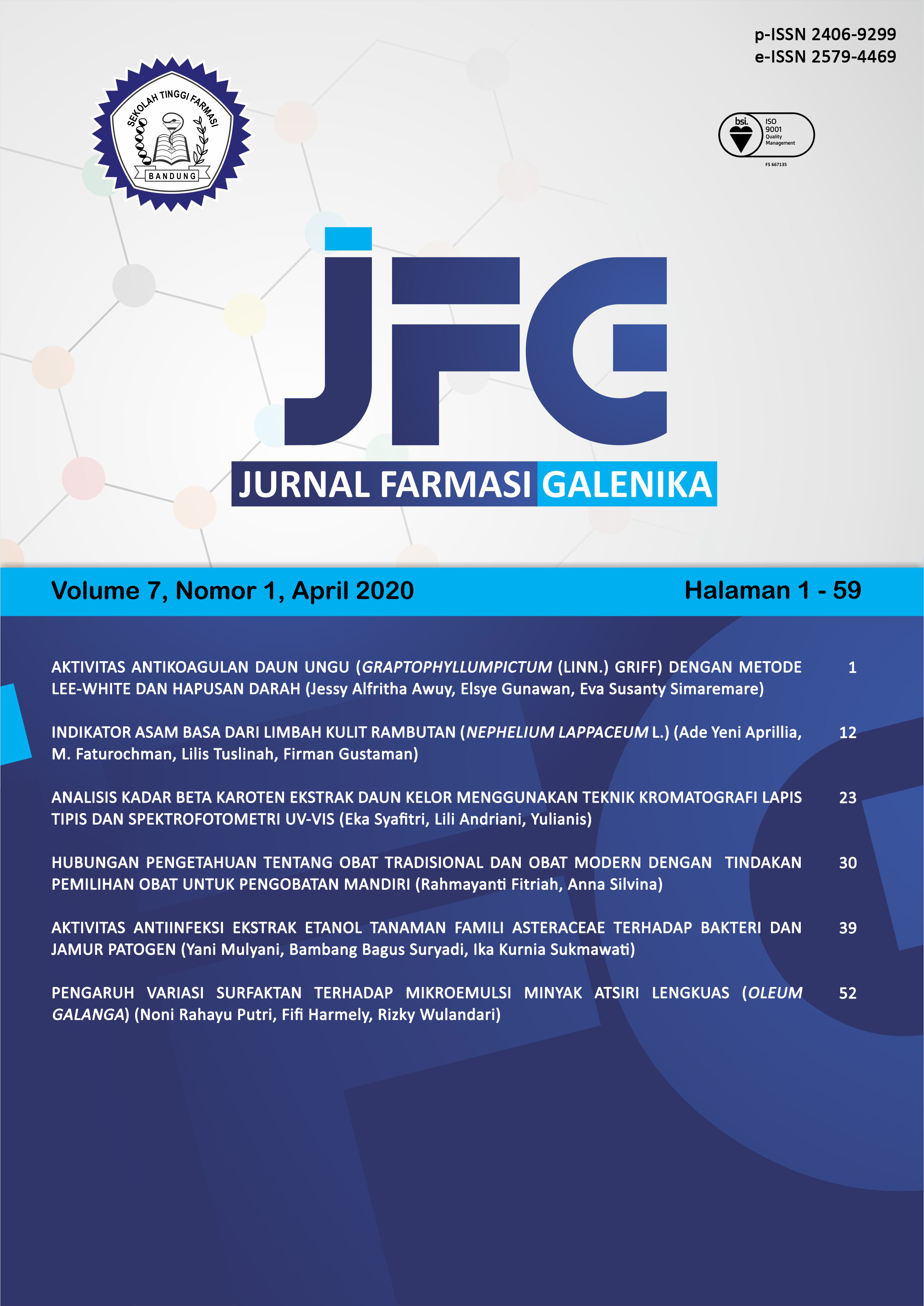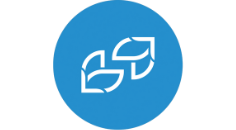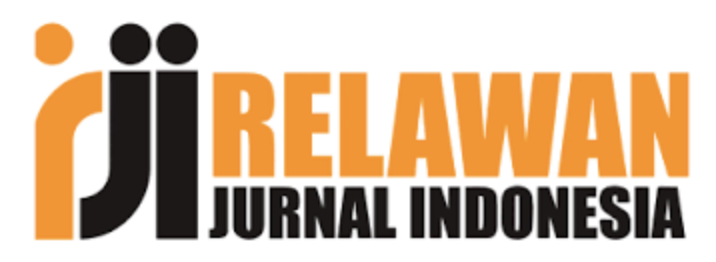AKTIVITAS ANTIINFEKSI EKSTRAK ETANOL TANAMAN FAMILI ASTERACEAE TERHADAP BAKTERI DAN JAMUR PATOGEN
DOI:
https://doi.org/10.70410/jfg.v7i1.172Keywords:
Asteraceae, antiinfeksiAbstract
Penyakit infeksi merupakan salah satu permasalahan kesehatan khususnya di negara berkembang dan terus meningkat dari tahun ke tahun. Peningkatan ini dikarenakan adanya resistensi obat, peningkatan infeksi oportunistik, dan infeksi jamur sistemik sehingga diperlukan alternatif baru untuk menanggulangi penyakit tersebut, salah satunya dengan penggunaan obat dari bahan alam yaitu tanaman famili Asteraceae. Famili Asteraceae sudah banyak digunakan secara tradisional di Kalimantan sebagai obat luka, selain itu banyak penelitian mengenai kajian aktivitas antimikroba dan kandungan senyawa aktif antimikroba yang terdapat pada tanaman tersebut. Penelitian ini bertujuan untuk mengetahui aktivitas tanaman famili Asteraceaeyaitu insulin, sambung nyawa, bandotan, sembung dan afrika terhadap bakteri Escherichia coli, Salmonella thypi, Vibrio cholera, Staphylococcus aureus, Streptococcus pyogenes, Bacillus cereus, dan jamur Candida albicans, Trichophyton mentagrophytes, Microsporum gypseum, Aspergillus niger, Microsporum canis, dan Malassezia furfur. Pengujian dilakukan dengan menentukan konsentrasi hambat minimum (KHM) dari ekstrak etanol daun dari kelima tanaman tersebut dengan metode difusi agar. Studi lanjut dilakukan dengan menentukan aktivitas antijamur dari ekstrak dengan KHM terbaik dengan melihat kurva pertumbuhan yang diperoleh dari penentuan time killing. Hasil menunjukkan bahwa ekstrak dengan aktivitas terbaik adalah ekstrak daun afrika terhadap jamur Trichophyton mentagrophytes (KHM = 0,025 mg/mL) dan terhadap bakteri Streptococcus pyogenes (KHM 0,75 mg/mL). Berdasarkan pengujian time killing, ekstrak tersebut memiliki aktivitas bakteriostatik dan fungistatik sampai konsentrasi 8 KHM.
Downloads
References
Bisht, V.K. ; Purohit, V. 2010. Medicine and Aromatic Plants Diversity of Asteraceae in Uttarakhand. Nature and Science. 2010;8(3):121-128.
Bramono, K. 2012. Chronic Recurrent Dermatophytosis In Tropics: Studies On Tinea Imbricata In Indonesia. Korean Journal of Medical Mycology; 17 (1) : 1-7.
Collins, H.C. & Lyne, M.P. 1970. Microbiological Methods 3th edition. Baltimore : University Park Press.
Darsana, I. Besung, I. Mahatmi, H. 2012. Potensi Daun Binahong (Anredera cordifolia (Tenore) Steenis) dalam Menghambat Pertumbuhan Bakteri Escherichia colisecara In Vitro. Indonesia Medicus Veterinus ; 1(3): 337-351.
Harborne, J.B. 2006. Metode Fitokimia Edisi ke-2. Bandung: ITB.
Hendra R, Ahmad S, Sukari A, Shukor MY. 2011. Oskoueian E. Flavonoid analyses and antimicrobial activity of various parts of Phaleria macrocarpa (Scheff.) Boerl fruit. International Journal Mol Sci. 2011;12: 3422-3431.
Hernani. 2011. Pengembangan Biofarmaka Sebagai Obat Herbal Untuk Kesehatan. Buletin Teknologi Pascapanen Pertanian. 2011; 7(1): 20-29.
Jiang, X., Feng, K., & Yang, X. (2015). In vitro antifungal activity and mechanism of action of tea polyphenols and tea saponin against Rhizopus stolonifer. Journal of molecular microbiology and biotechnology, 25(4), 269-276.
Liu J dan Nes W D. 2009. Steroidal triterpenes: design of substrate-based inhibitors of ergosterol and sitosterol synthesis. Molecules. ; 14(11): 4690-4706.
Madduluri, Suresh. Rao, K.Babu. Sitaram, B. 2013. In Vitro Evaluation of Antibacterial Activity of Five Indegenous Plants Extract Against Five Bacterial Pathogens of Human. International Journal of Pharmacy and Pharmaceutical Sciences: 5(4): 679-684.
Mulyani, Y., dkk. 2011. Kajian Aktivitas Antibakteri Ekstrak Etanol dan Fraksi Daun Singawalang (Petiveria alliaceae) terhadap bakteri resisten. Majalah Farmasi Indonesia (22)4: 293-299.
Mulyani, Y., Ryana, N., & Selifiana, N. 2019. Kajian Etnofarmakologi Tumbuhan Obat Oleh Masyarakat Di Kecamatan Tanta Kabupaten Tabalong Provinsi Kalimantan Selatan. Jurnal Insan Farmasi Indonesia, 2(2), 194-204.
Mycek, M.J., Harvey, R.A., Champe, P.C., Fisher, B.D. 2001. Farmakologi Ulasan Bergambar: Obat-obat Antijamur. Edisi 2. Jakarta: Widya Medika.
Nuria, Maulita cut, Faizaitun, Arvin, Sumantri. 2009. Uji Aktivitas Antibakteri Ekstrak Etanol Daun Jarak Pagar (Jatropha Curcas L) Terhadap Bakteri Staphylococcus Aureus Atcc 25923, Escherichia coli Atcc 25922, Dan Salmonella Typhi Atcc 1408, Mediagro ;5(2):26–37.
Salehan, N. M., Meon, S., & Ismail, I. S. (2013). Antifungal activity of Cosmos caudatus extracts against seven economically important plant pathogens. International Journal of Agriculture and Biology, 15(5).
Salni, Marisa H, Mukti R.W. 2011. Isolasi Senyawa Antibakteri Dari Daun Jengkol (Pithecolobium lobatum Benth) dan Penentuan Nilai KHM-nya. Jurnal penelitian sains vol. 14 Ed. 1 (D): 38-41.
Setiabudy, R. & Bahry, B. 2007. Farmakologi dan Terapi: Obat Jamur Edisi 5. Jakarta: Fakultas Kedokteran Universitas Indonesia.
Watson, R.R. Dan Preedy V.R. 2007. Bioactive Foods in Promoting Health: Probiotics and Prebiotics. USA: Academic Press.
Wegiera, M. ; Helena, DS. ; Marcin, J.D. ; Magdalena, K. ; Kamila, K. 2012. Cytotoxic Effect of Some Medical Plants from Asteraceae Family. Acta Poloniae Pharmaceutica. Mar-Apr; 69(2): 263-268.
Downloads
Published
How to Cite
Issue
Section
Citation Check
License
Copyright (c) 2020 JURNAL FARMASI GALENIKA

This work is licensed under a Creative Commons Attribution 4.0 International License.
Authors who publish in Jurnal Farmasi Galenika agree to the following terms:
This license enables reusers to distribute, remix, adapt, and build upon the material in any medium or format, so long as attribution is given to the creator. The license allows for commercial use. CC BY includes the following elements:
BY: credit must be given to the creator.
You are free to:
- Share — copy and redistribute the material in any medium or format for any purpose, even commercially.
- Adapt — remix, transform, and build upon the material for any purpose, even commercially.
- The licensor cannot revoke these freedoms as long as you follow the license terms.
Under the following terms:
- Attribution — You must give appropriate credit , provide a link to the license, and indicate if changes were made . You may do so in any reasonable manner, but not in any way that suggests the licensor endorses you or your use.
- No additional restrictions — You may not apply legal terms or technological measures that legally restrict others from doing anything the license permits.
Notices:
You do not have to comply with the license for elements of the material in the public domain or where your use is permitted by an applicable exception or limitation .
No warranties are given. The license may not give you all of the permissions necessary for your intended use. For example, other rights such as publicity, privacy, or moral rights may limit how you use the material.




1.jpg)







